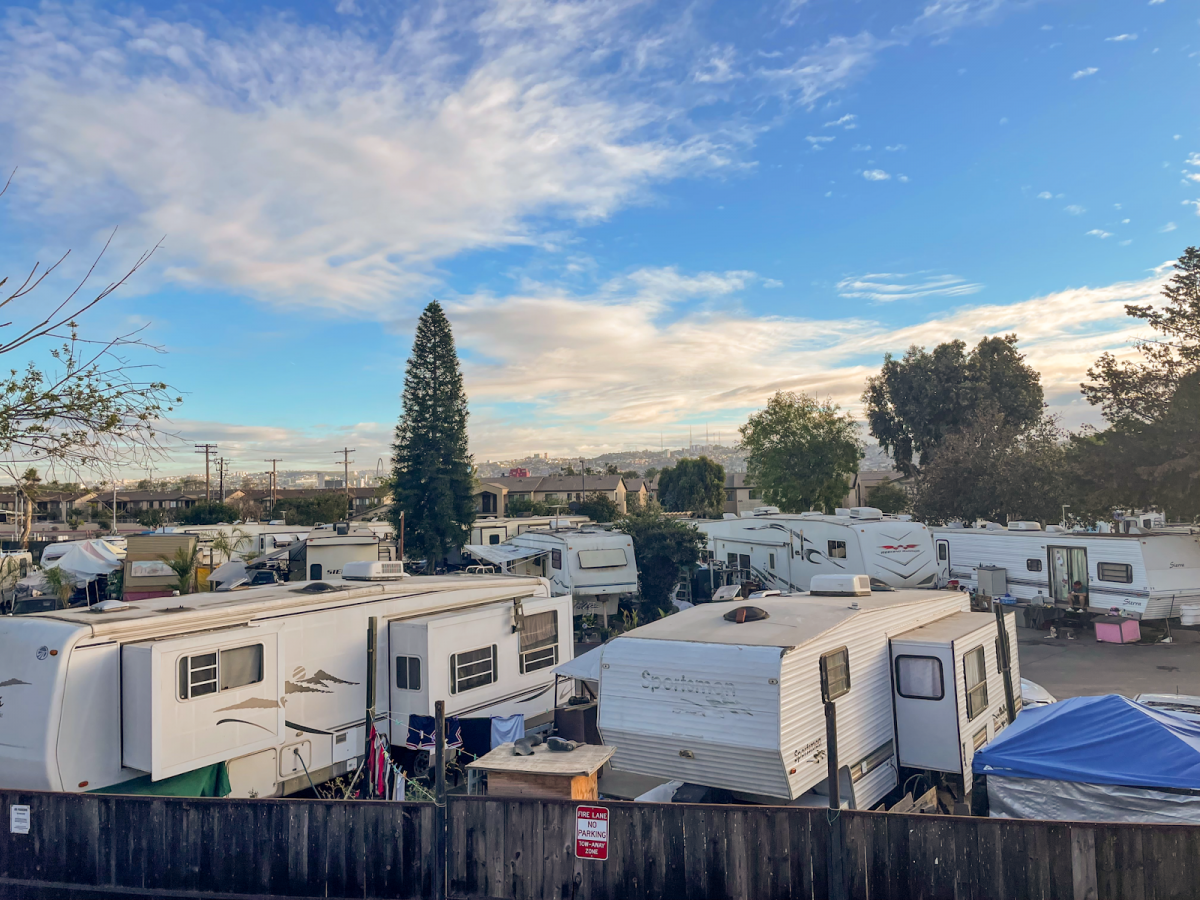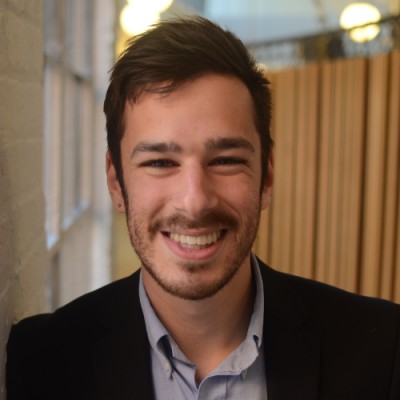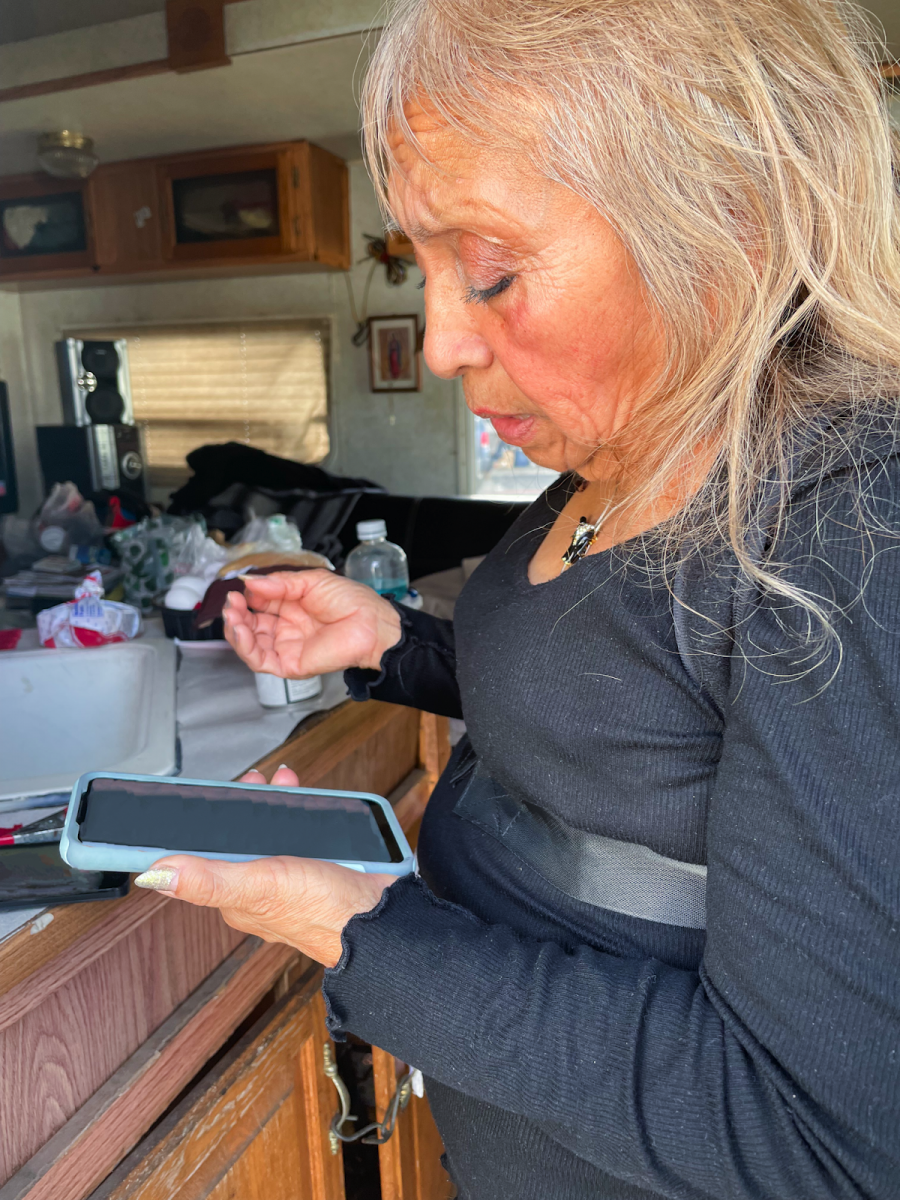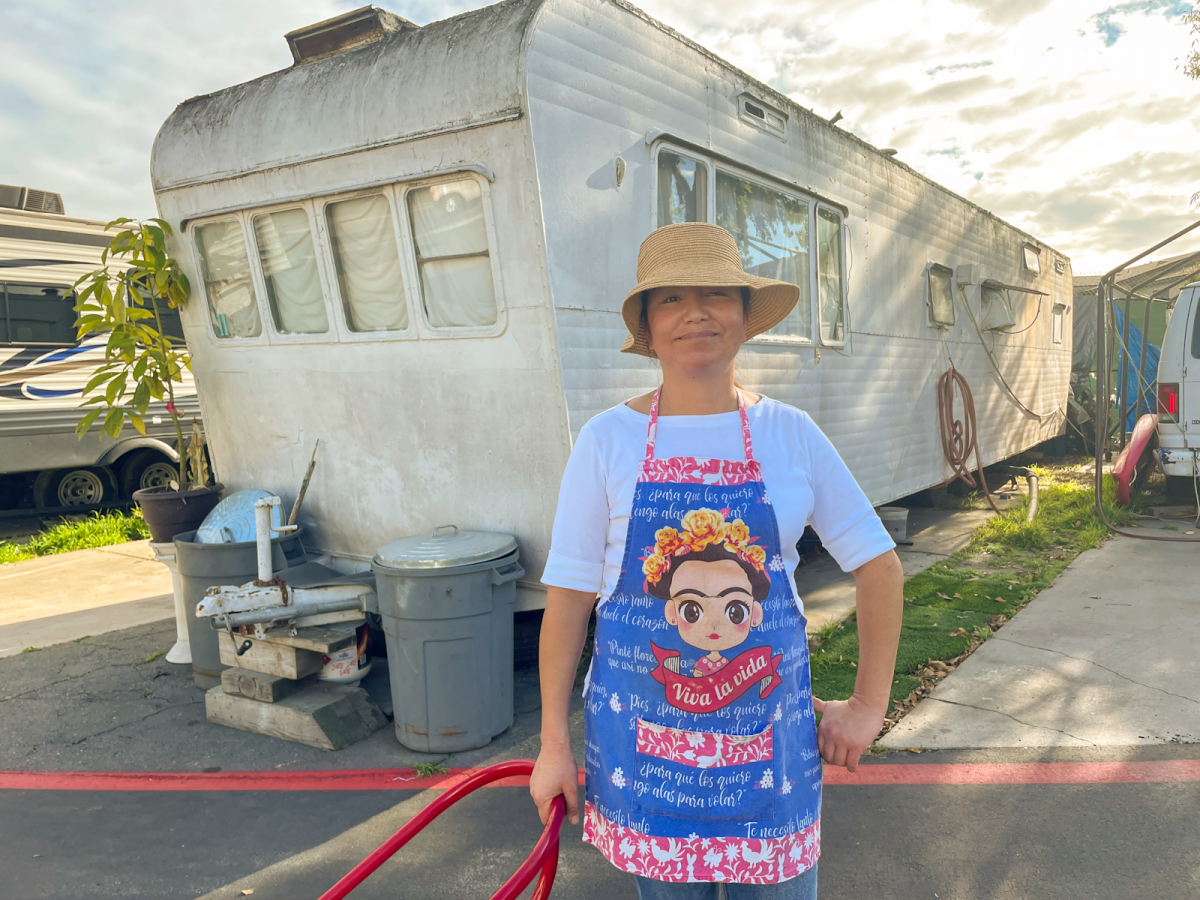As telephone companies tout the switch to 5G, these San Diego residents still lack reliable cell service
Monday, March 7, 2022
Digital Beat
As telephone companies tout the switch to 5G, these San Diego residents still lack reliable cell service

Roughly 30 trailers abut the Motel 6 in San Ysidro, a border neighborhood in San Diego. These homes lack wired internet infrastructure like DSL or fiber, and many residents rely on the cellular data from nearby towers. In the distance is Tijuana, Mexico.

Guadalupe Olivo has been trying to call her doctor about an appointment, but she can’t get through. “Cellular network is not available,” her phone reads when she tries to dial again.
Ever since her car accident last year, Olivo has been waking up feeling dizzy, but it’s her cell service that really flusters her.
“I can’t figure out when the appointment is, whether it’s the 22nd or 23nd, because the call doesn’t go through,” said Olivo in Spanish. Even when her service does work, there’s no guarantee that the person on the other line can speak Spanish, the only language she speaks.
Olivo lives in San Ysidro, a neighborhood in San Diego that is adjacent to one of the world’s busiest border crossings and nestled within one of North America’s largest metropolitan regions. And yet, wireless networks, which are responsible for cellular signals and data, are spotty here. For the residents like Olivo who live in the manufactured home park behind the Motel 6, that poor cell service has become a daily reminder of the digital divide, i.e., the disparities in access to technology both in San Diego and throughout much of the US.

Gudalupe Olivo lives with her adult son in a 1-bedroom trailer in the San Ysidro border area of San Diego. She struggles to use her phone to reach her doctor because of the area’s poor cellular service and due to her discomfort with technology.
Sol Aguilar, a sales representative at a San Ysidro T-Mobile store, sees two to three customers a week at Metro by T-Mobile who complain about dropped calls. “It’s kind of annoying dealing with it all the time, but you’re so used to it now.”
Wendy Aguayo is one of Olivo’s neighbors, living in a nearby trailer with her husband and two children, 11 and 18 years old. She is friendly and smiling, even while multitasking. While taking care of her children, she is active in her neighborhood, participating in a National Institutes of Health-funded study on COVID-19 testing equity and training to become a teacher on issues around domestic violence. In both cases, classes and workshops are online, often over Zoom, so she sets up a hotspot using her smartphone because the home park doesn’t support wired internet like DSL or fiber.
For more on access and home parks see Digital Access at the Doorstep: The Park Plaza Cooperative
That means when the cellular signal fails, her classes abruptly end. Lately, this has been happening once or twice a week.
Across the street from the home park is the local elementary school, which serves 772 students, including Aguayo’s son. More than 95 percent of students are Hispanic. “The internet is not the best here, but we make do,” said Todd Lewis, the Director of Education Technology for the San Ysidro School District. As for the cellular network, it “depends on what spot I’m standing on,” he said. Once in December of last year, the YMCA after-school program hosted at the elementary school was unable to take attendance for students because the sign-in and sign-out sheets require an internet connection.
As wireless communication becomes increasingly essential, poor cell signals can have dire consequences. But as the technology becomes more complex, like with the transition to 5G, solving the problem is increasingly difficult. “There are half a dozen variables,” said Benton Senior Counselor Andrew Jay Schwartzman. Sometimes, the cell tower engineers simply make a mistake and accidentally broadcast a weaker signal than needed. Inferior cellular signals and slow data can be a result of geography, like living in a valley when the cell tower is on a hill. It can also arise from being around certain buildings that are less permeable to electromagnetic waves, or it can stem from a cheap phone that isn’t as sensitive to modern wireless signals. The last problem, cheap phones, hits low-income customers particularly hard.

Wendy Aguayo volunteers throughout San Ysidro but is often stymied by connectivity. She lacks wired internet at home, and her cellular connection cuts out two to three times a week.
These problems can exist anywhere in the US, but the proximity to the US-Mexican border adds another set of complicating factors for residents in San Ysidro. “Trans-border spectrum interference issues have been with us forever,” said Schwartzman. Mexican radio and TV stations blur into US networks and vice versa, often without much complaint. But the growing reliance on cellular devices—especially for communities without wired internet during the COVID-19 pandemic— raises the stakes.
In August 2019, a Mexican company, Altán Redes, began testing new cellular networks for communities in northern Mexico. Those Mexican signals interfered with American cellular networks, leading hospitals and first responders on the US side of the border to experience widespread outages. For months, firefighters in San Diego were having trouble placing or receiving emergency calls. Senator Ted Cruz (R-TX) wrote to the Federal Communications Commision (FCC) on behalf of the thousands of Texans affected, leading the State Department to intervene eventually. The San Diego Fire Department hasn’t experienced any such issues since January 2020, and the city councilmember representing San Ysidro, Vivan Moreno, hasn’t heard any recent complaints from constituents either. FCC Chairwoman Roserworcel acknowledged last year that the government is still investigating the problem but did not respond when asked whether the issue could still be affecting residents like Olivo and Aguayo.
Meanwhile, the city of San Diego is proposing to double its investment in digital equity this year and is already offering digital literacy classes along the border areas. They’ve also built out “WiFi transmission centers” in San Ysidro, said Gerardo Ramirez, the community representative for Councilmember Moreno.
Aguayo is skeptical though. The city’s map of public Wi-Fi shows fewer resources for the border communities. “I was in a community meeting, and they were talking about free internet San Diego or something like that, but there isn’t anything,” she said while sitting down next to a playground a few blocks from her home, watching her 11-year old son race around as the sunset colors the clouds in pink. She recently switched from Metro by T-Mobile to Cricket Wireless, and the service is better, though far from where she needs it to be.
The San Ysidro School District has distributed hotspots to families who lacked strong internet connections at home. However, those hotspots rely on a cellular signal. In-person classes have resumed, but homework remains online. When the hotspots invariably fail, Aguayo takes her younger son to a neighbor's home so he can finish his school work. Her older son finishes his homework from Southwestern Community College at the local library.
Olivo has sought out her own solutions, too. She recently bought a second phone, hoping that the issue was her phone and not the signal. But now she is struggling to navigate the upgraded buttons and colors of the new screen. Until then, her new phone serves as paper weight most of the time.
Benton Fellow Adam Echelman is a writer and long-time practitioner on digital equity. He is the former Executive Director of Libraries Without Borders US and the founder of Baltimore's Digital Equity Coalition.
The Benton Institute for Broadband & Society is a non-profit organization dedicated to ensuring that all people in the U.S. have access to competitive, High-Performance Broadband regardless of where they live or who they are. We believe communication policy - rooted in the values of access, equity, and diversity - has the power to deliver new opportunities and strengthen communities.
© Benton Institute for Broadband & Society 2022. Redistribution of this email publication - both internally and externally - is encouraged if it includes this copyright statement.
For subscribe/unsubscribe info, please email headlinesATbentonDOTorg






